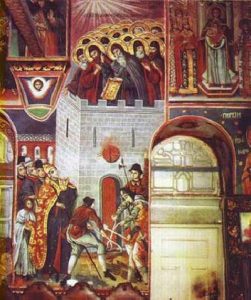 When Emperor Michael Palaeologus contracted the infamous Union of Lyons with the pope, in order to obtain help from the West against the Bulgarians and Serbs, the monks of the Holy Mountain sent a protest to the emperor against this Union, imploring him to reject it and return to Orthodoxy. The pope dispatched an army to help the emperor. The Latin army entered the Holy Mountain and committed such barbarism as the Turks had never committed in five hundred years. Having hanged the Protaton, and having killed many monks in Vatopedi, Iveron and other monasteries, the Latins attacked Zographou. The blessed Abbot Thomas warned the brethren that whoever wished to be spared from the Latins should flee from the monastery, and that whoever desired a martyr’s death should remain. And so, twenty-six men remained: the abbot, twenty-one monks, and four laymen who served as laborers for the monastery. They all closed themselves in the monastery’s tower. When the Latins arrived, they set fire to the tower and these twenty-six heroes of Christ found a martyr’s death in the fire. While the tower was burning, they chanted the Psalms and the Akathist to the Most-holy Mother of God. They gave their holy souls to God on October 10, 1283. In December of the same year, the dishonorable Emperor Michael died in poverty, when the Serbian King Milutin rose up against him in defense of Orthodoxy.
When Emperor Michael Palaeologus contracted the infamous Union of Lyons with the pope, in order to obtain help from the West against the Bulgarians and Serbs, the monks of the Holy Mountain sent a protest to the emperor against this Union, imploring him to reject it and return to Orthodoxy. The pope dispatched an army to help the emperor. The Latin army entered the Holy Mountain and committed such barbarism as the Turks had never committed in five hundred years. Having hanged the Protaton, and having killed many monks in Vatopedi, Iveron and other monasteries, the Latins attacked Zographou. The blessed Abbot Thomas warned the brethren that whoever wished to be spared from the Latins should flee from the monastery, and that whoever desired a martyr’s death should remain. And so, twenty-six men remained: the abbot, twenty-one monks, and four laymen who served as laborers for the monastery. They all closed themselves in the monastery’s tower. When the Latins arrived, they set fire to the tower and these twenty-six heroes of Christ found a martyr’s death in the fire. While the tower was burning, they chanted the Psalms and the Akathist to the Most-holy Mother of God. They gave their holy souls to God on October 10, 1283. In December of the same year, the dishonorable Emperor Michael died in poverty, when the Serbian King Milutin rose up against him in defense of Orthodoxy.
Heroes of Zographou, knights of truth,
Sacrificed themselves for the Orthodox Faith,
And shamed the proud, shameless Latins,
As their souls rose up to the Kingdom of God.
The tower’s flames mounted up to heaven,
As the monks in the fire sent up praise to God!
Heaven with its angels beheld that scene,
As the criminals crawled about like worms below the tower.
In the flames, Abbot Thomas, a true parent,
Encouraged his brothers, and began the Psalms:
He who glorifies the Lord does not fear death,
And he who dies for God will not perish.
The sacrifice is offered, and the altar of oblation remains:
The bodies were burned, the souls flew off,
And by that sacrifice, Zographou increased in glory
With magnificence eternal and true.
St. George the knight, cherishes his knights
As the Mother of God cherishes all heavenly citizens.
In these knights of righteousness, the Church rejoices:
They are her children, her fruitful branches.
REFLECTION
By God’s providence, the greatest number of miracles and heavenly manifestations occur during the martyrdom of His servants. On the day that the Latins set out for the Monastery of Zographou, an old monk had an obedience in a vineyard half an hour’s distance from the monastery. At the prescribed time, he read the Akathist before the icon of the Mother of God. However, when he began to pronounce the word “Rejoice!” a voice came to him from the icon: “Do thou also rejoice, O elder! Flee from here now, or misfortune will befall thee; go and tell the brethren of the monastery to lock themselves in, for the God-opposing Latins have attacked this, my chosen Mountain, and are already near.” The frightened elder fell to his knees and cried out in fear: “How can I leave thee here, my Queen and Intercessor?” At this he again heard the voice: “Do not worry about me, but go quickly!” The elder went to the monastery immediately. But when he reached the monastery gates he beheld that same icon of the Mother of God. In a miraculous manner, the icon had preceded him to the monastery. The amazed elder related all that had been revealed to him to the abbot and the brethren. At that, all of them glorified God and the Mother of God.
Once, during the celebration of the Feast of the twenty-six martyrs of Zographou, on October 10, 1873, there was a great all-night vigil. It was a moonless night. In the middle of the night, while the monks were chanting and reading the lives of the holy martyrs in the church, a noise was suddenly heard, and over the church a fiery pillar appeared, extending from earth to heaven. It was so bright that things at a distance could be seen as though it were midday. This wondrous manifestation lasted for about a quarter of an hour and then disappeared.
